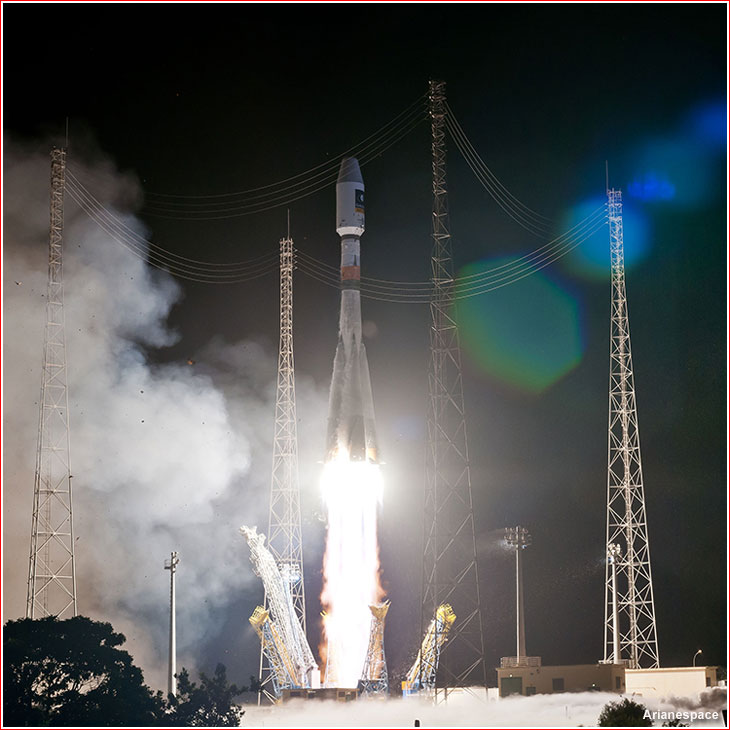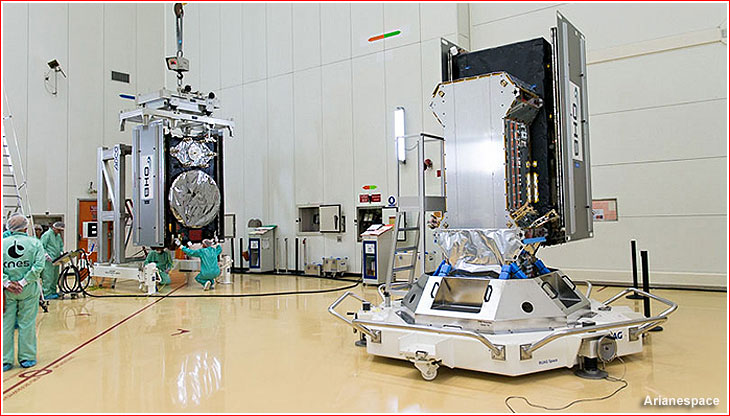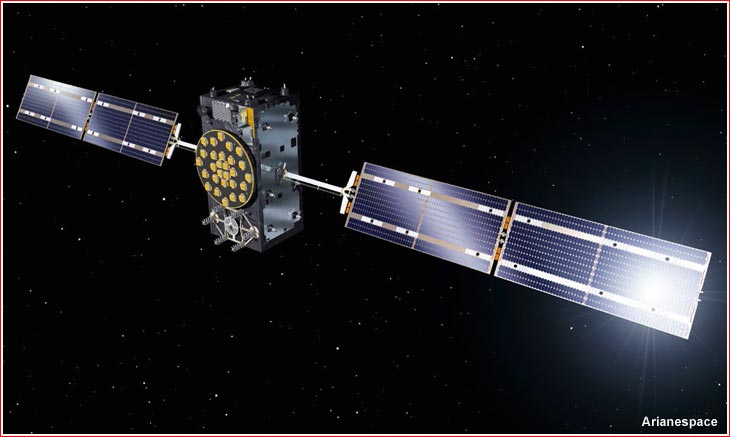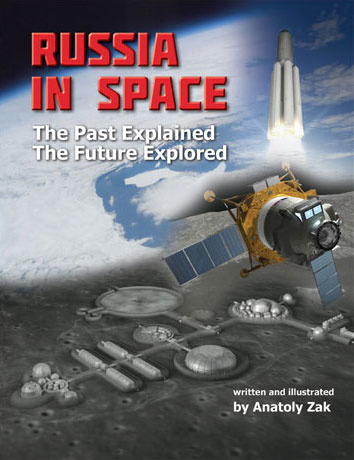Soyuz VS 12 launch with Galileo FOC M3 satellites (original) (raw)
Soyuz-ST flies its 7th mission with Galileo satellites
On Sept. 10, 2015, a Soyuz rocket lifted off from its launch pad in French Guiana, successfully delivering a pair of Galileo FOC-M3 satellites.
Previous Galileo launch: VS11 FOC-M2

Soyuz-ST-B/Fregat-MT rocket lifts off on Sept. 10, 2015, with a pair of Galileo FOC-M3 satellites.

Initial launch profile of the Soyuz-ST rocket (mission VS 12) with Galileo FOC-M3 satellites in September 2015. Credit: Arianespace

Mission profile of the Soyuz-ST rocket (mission VS12) with Galileo FOC-M3 satellites in September 2015. Credit: Arianespace
From the publisher: Pace of our development depends primarily on the level of support from our readers!
Seventh Galileo mission (VS 12) in September 2015
The liftoff of the Soyuz-ST-B/Fregat-MT rocket from the ELS pad near Kourou, French Guiana, took place as scheduled on Sept. 10, 2015, at 11:08:10 p.m. local time in French Guiana (10:08 p.m. EST). (It was already September 11, 02:08 GMT and 06:08 Moscow Time.) The 12th Soyuz launch from Guiana (under designation VS12) carried a total of 1,601 kilograms of payload, including a pair of Galileo FOC-M3 satellites and a dispenser built by RUAG Space.
These were the fifth and sixth FOC (Full Operational Capability) spacecraft in Europe’s Galileo navigation program, which have been designated "Alba" and "Oriana" – continuing the naming process after children who won a painting competition organized by the European Commission in 2011. Counting four In-orbit Validation, IOV, satellites, they were 9th and 10th spacecraft in the operational Galileo constellation.
Preparations for launch
Galileo satellites No. 9 and No. 10 arrived to French Guiana aboard a Boeing-747 transport plane on July 27, 2015, landing at Félix Eboué International Airport near Cayenne. At the end the same month, specialists conducted initial fit checks between both satellites and their payload dispenser at the S1A clean room facility in Kourou.
Fueling of both satellites took place on August 26, 2015, at the S3B clean room facility in Kourou. In the same building, on August 31, 2015, the duo was installed on its side-by-side dispenser system.

The Soyuz-ST rocket was rolled out from its integration building to the launch pad on the morning of Sept. 7, 2015
Flight profile
According to Arianespace, which manages this mission for the European Space Agency, the powered phase of the first, second and third stages on Soyuz was to last about nine minutes. The third stage of the launcher will then be separated from the upper composite, comprising the Fregat upper stage and the two satellites. The three lower stages and the fairing will fall back into the sea.
After a first burn, the upper composite is spinned during a ballistic phase lasting about three hours and 15 minutes. Then, Fregat will ignite its own engine to bring the upper composite to an orbit over the Earth. At a pre-determined point of this orbit, Fregat will ignite a second burn lasting four minutes to reach the circular orbit of separation. At the end of the mission, the Fregat upper stage will be deactivated.
The entire orbital insertion process is expected to conclude three hours, 47 minutes after the liftoff with the release of the satellites into a 23,522-kilometer orbit with an inclination 57.394 degrees toward the Equator.
The satellites will later use their own propulsion system to lower their altitude in order to enter their operational orbit in the orbital plane A of the Galileo constellation.
Galileo FOC-M3 launch sequence on Sept. 10, 2015:
| PRE-LAUNCH EVENTS | Time (h:min:sec) |
|---|---|
| Beginning of the State Commission meeting for launcher fueling authorization | -05:00:00 |
| Beginning of Launch Vehicle fueling with propellant components | -04:30:00 |
| Launch Vehicle is fueled with all propellant components | -01:35:00 |
| Mobile gantry withdrawal | -01:10:00 |
| Key on start (beginning of Soyuz synchronized sequence) | -00:05:10 |
| Fregat transfer to onboard power supply | -00:05:00 |
| Upper Composite umbilical drop off command | -00:02:25 |
| Ground-board power transfer | -00:00:40 |
| Lower stage mast retraction | -00:00:28 |
| Ignition | -00:00:17 |
| Preliminary thrust level | -00:00:15 |
| Full thrust level | -00:00:03 |
| LAUNCH EVENTS | - |
| Lift-off | 00:00:00 |
| Jettisoning of 1st stage boosters at an altitude of 45 kilometers | 00:01:58 |
| Jettisoning of fairing | 00:03:29 |
| Separation of the core (2nd) stage at an altitude of 150 kilometers | 00:04:48 |
| Separation of the 3rd stage | 00:09:24 |
| Fregat 1st burn starts | 00:10:24 |
| Fregat 1st burn ends | 00:23:32 |
| Fregat 2nd burn starts | 03:38:35 |
| Fregat 2nd burn ends | 03:42:57 |
| Separation of FOC-M3 No. 9 and No. 10 into an orbital plane A of the Galileo constellation | 03:47:57 |
Galileo FOC satellites

The current Galileo satellites are built by Bremen-based OHB System as prime contractor, with their navigation payloads provided by Surrey Satellite Technology Ltd. UK, a 99%-owned subsidiary of Airbus Defense and Space. The two spacecraft to be orbited by Arianespace on Flight VS12 will be the fifth and sixth OHB-built satellites.
Known specifications of Galileo FOC-M3 No. 9 Alba and No. 10 Oriana:
| Customer | ESA (European Space Agency) |
|---|---|
| Contractors | OHB-System (satellite bus and a prime contractor) SSTL (payload) |
| Total mass at lift-off | 714.6 kilograms and 713.2 kilograms |
| Dimensions | 2.5 by 1.2 by 1.1 meters and 14,67 meters solar panels span when deployed in orbit |
| Life span | More than 12 years |
| On-board power | 1,420 Watts |
| Navigation signal | 3 bands (E5, E6 and E1) |
| Additional payload | COSPAS-SARSAT search and rescue transponder |
Next Galileo launch: VS13 FOC-M4
Read much more about the history of the Russian space program in a richly illustrated, large-format glossy edition:
The article by Anatoly Zak; Last update:December 16, 2015
All rights reserved
IMAGE ARCHIVE
Ninth and tenth Galileo satellites attached to their dispenser being lowered on top of the Fregat upper stage on Sept. 2 in the 3SB preparation building in Kourou, French Guiana. Click to enlarge. Credit: ESA
Click to enlarge. Credit: Arianespace
Galileo satellites are being enclosed into the payload fairing of the Soyuz ST-B rocket. Click to enlarge. Credit: Arianespace
On Sept. 7, 2015, the upper composite containing Galileos No. 9 and No. 10 satellite was transferred to the launch pad, then hoisted up to the top of the Soyuz launch tower to be joined to the other stages. Click to enlarge. Credit: ESA
Payload section with Galileo satellites No. 9 and 10 shortly after its integration with the Soyuz-ST-B rocket on the launch pad in Kourou. Click to enlarge. Credit: Arianespace
Soyuz-ST-B/Fregat-MT rocket lifts off on Sept. 10, 2015, with a pair of Galileo FOC-M3 satellites. Click to enlarge. Credit: Arianespace
Artist rendering depicting separation of the 1st-stage boosters from the Soyuz-ST rocket during the delivery of Galileo FOC satellites. Click to enlarge. Credit: Arianespace
Artist rendering depicting fairing separation from the Soyuz-ST rocket during the delivery of Galileo FOC satellites. Click to enlarge. Credit: Arianespace
Artist rendering of separation between the core stage and the third stage of the Soyuz-ST rocket. Click to enlarge. Credit: Arianespace
Artist rendering of Galileo FOC satellites and their Fregat upper stage separating from the 3rd stage of Soyuz-ST launch vehicle. Click to enlarge. Credit: Arianespace
Artist rendering depicting the Fregat upper stage firing its engine during the delivery of Galileo FOC satellites. Click to enlarge. Credit: Arianespace
Artist rendering of Galileo FOC satellites separating from the Fregat upper stage. Click to enlarge. Credit: Arianespace


)
)
)
)
)
)
)
)
)
)
)
)